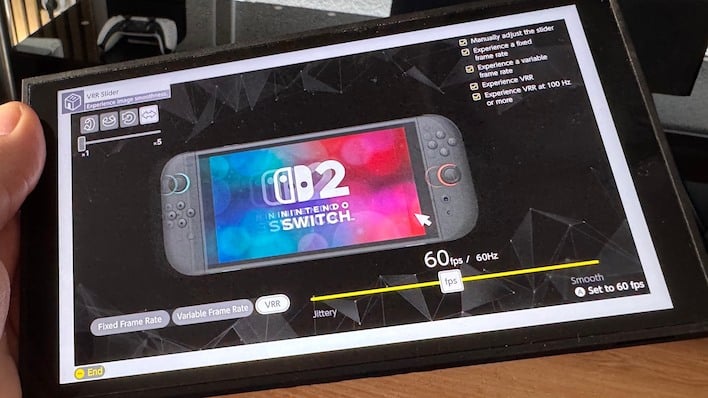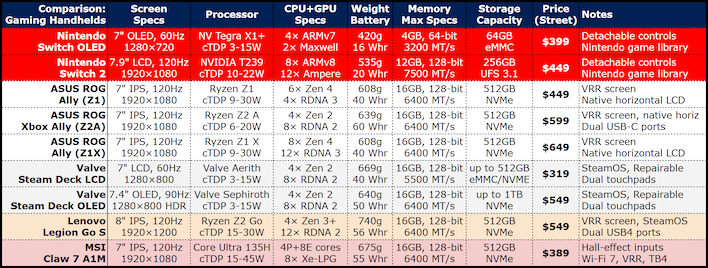Nintendo Switch 2 Vs ROG Xbox Ally: Handheld Gaming Powerhouses Compared
Pricing-wise, though, the real rival matchup here is the Nintendo Switch 2 versus the standard ROG Xbox Ally, with Switch 2 available for $499 with a bundled game (or $449 without) and ROG Xbox Ally starting at a pre-order price point of $599. That's $100-$150 more for the Xbox-branded handheld, and a lot of money to ask for most gamers in this economy—especially if they already have a competent home PC or are looking to buy only one gaming machine this generation.
So, is the extra money worth it? Why or why not? Let's explore this head-to-head compare...
Nintendo Switch 2 vs ROG Xbox Ally: Display Wars
Despite the fact that, on paper, the Nintendo Switch 2 and ASUS ROG Xbox Ally are both built around 7-inch IPS screens with 1080p resolution and a variable 120Hz refresh rate, the two displays may as well be in entirely separate classes of performance. The reason for this is sadly because Nintendo either didn't invest in an actually-good LCD panel, or simply refuses to tweak it properly in its firmware, so it has horrendous motion handling despite technically supporting a 120Hz refresh rate. We, like many other outlets, have speculated that this may be due to a lack of LCD overdrive for power-saving reasons.We don't yet have the ROG Xbox Ally in our hands, but we can state with some confidence based on the last-gen ROG Ally handhelds that things will almost certainly be blow-out in favor of ROG Xbox Ally, as the previous Ally machines boast excellent motion clarity in 120Hz operation. Of course, games able to consistently hit 120 FPS in 1080p will be rare on either platform, but the motion clarity artifacts on the Nintendo Switch are severe enough to matter even in 30 FPS games like Cyberpunk 2077. This category is a clear win for the ROG Xbox Ally, but this is only the first battle.
Nintendo Switch 2 Vs ROG Xbox Ally: Storage And Expansion Options
Next, let's talk storage and expansion options. The Nintendo Switch 2 has 256 GB of internal storage, using UFS 3.1 flash storage comparable to a proper NVMe SSD at roughly 2100 MB/s. Sadly, all other forms of storage on Switch 2 fall short in comparison, with the SD Express standard for SD cards limited to roughly ~900 MB/s, and the actual game cards limited to an estimated 600 MB/s.
This is part of the reason why a number of Nintendo Switch 2 releases that are ported from current-generation platofrms launch without physical versions, or resort to pseudo-physical versions that still require a download—if the game is reliant on NVMe-tier SSD speeds to load assets quickly enough, SD Express and the game cartridge slot might not be able to keep up. Even overall loading times of games supported on all three formats have been benchmarked dramatically faster on internal storage versus all other methods.
As one would expect from a modern PC handheld, then, the ASUS ROG Xbox Ally ships with a 512 GB PCIe 4.0 x4 SSD in the standard 2280 format, which makes it user-replaceable. This is a clear win over the soldered-down 256GB of UFS storage in the Switch 2, but the story reverses when we talk about storage expansion. The Switch 2's SD Express slot offers much better performance than the UHS-1 MicroSD slot on the ROG Xbox Ally. With a compatible Sandisk MicroSD card, that slot can potentially reach a mediocre peak of 200 MB/second, which is still far behind even the Switch 2's game cards, to say nothing of the MicroSD Express slot, and that's only with a QuickFlow compatible MicroSD card—most cards will be limited to 104 MB/second.
Furthermore, that's a sequential transfer rate that has little to do with the random access performance required for rapid game loading. Simpler titles that you might be likely to play on the go will probably launch fine off of these cards, but demanding AAA games are likely to suffer I/O bottlenecks from a common UHS-1 MicroSD card. You can get around this limitation by connecting to a USB 3.2 Gen 2 storage device—something the Switch 2 can't do—but that requires you to carry around extra hardware or tethers you in place, if you're using a docking station. We're going to call this one for the Switch 2, although it's a close race and rather subjective depending on your situation and use case.
Nintendo Switch 2 vs ROG Xbox Ally: Form Factor
Now, this one may be somewhat contentious, but if you haven't used both a Nintendo Switch and a PC handheld like the Steam Deck or ROG Ally before, you may not immediately understand the point being made here. The thing is, the general consensus among players who have used both a Switch handheld and a bulkier PC handheld is that the PC handhelds are actually more comfortable, even though they are universally heavier than Nintendo's machines. The reason for this is because the flat form factor of the Switch and Switch 2 doesn't actually allow you to get a solid grip with which to support the device.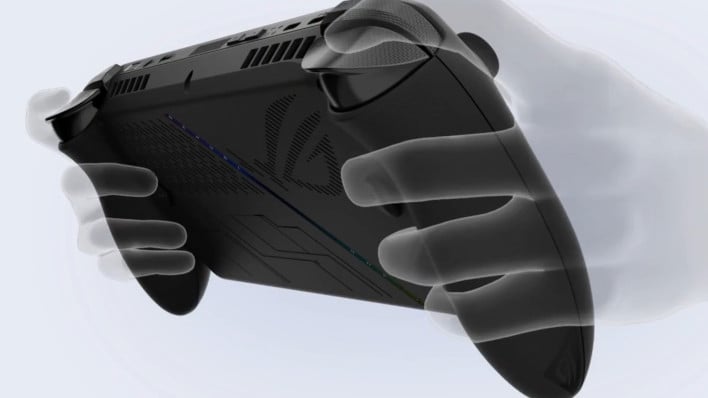
The full handles available on the like of the ROG Ally handhelds and indeed the Steam Deck allow for longer and more comfortable gaming sessions without disproportionately straining the bottom two fingers on both hands. Nintendo made improvements to ergonomics on the Switch 2, and there are third-party Switch 2 Joy-Con grips that give you bigger handles, but ultimately this is far-and-away an easy win for the ASUS ROG Xbox Ally. The large handgrips on the device hurt portability a little, but you're probably going to need a case either way, and the ability to play for more than 30 minutes without your hands cramping is very nice.
Nintendo Switch 2 Vs ROG Xbox Ally: Price For Performance
This is where things get interesting, especially for those leaning toward the Nintendo Switch 2. You see, the ASUS ROG Xbox Ally is more or less using the exact same hardware that released with the Steam Deck, and in combination with its Windows OS, that puts it at a significant disadvantage versus Nintendo's system. Allow us to explain.Valve's machine utilizes a custom APU known as "Aerith" in its 7nm guise, and "Sephiroth" in its 6nm form. Either way, it comes with 4 cores and 8 threads of AMD's Zen 2 CPU architecture, as well as eight AMD RDNA 2 compute units, all stuffed into a 3 to 15-watt adjustable power envelope. From all appearances, the AMD Ryzen Z2 A APU inside the ROG Xbox Ally is based on the exact same silicon, though it's not clear if it's "Aerith" or "Sephiroth" yet. Despite using the same chip, though, it may not even reach the same heights of performance as the Steam Deck because it still has to run Windows 11, and we've recently observed that SteamOS can outperform Windows 11 on these devices in our review of the Lenovo Legion Go S with SteamOS.
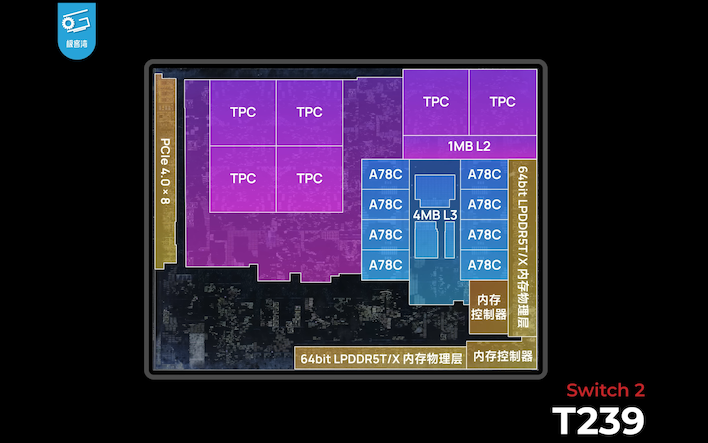
In comparison, the Switch 2's Tegra T239—supposedly codenamed "Drake"—has eight Arm Cortex-A78C CPU cores and an integrated GPU with 12 Shader Modules based on NVIDIA's Ampere architecture that powered the GeForce RTX 3000 series. It has a few major advantages over the RDNA 2 GPU in the Steam Deck; most notably, it includes NVIDIA's Tensor Cores for AI processing. It also has radically improved ray-tracing performance and benefits from the use of an extremely low-level graphics API known as NVN, created by NVIDIA and exclusive to the Nintendo platform.
What does that mean for this comparison? On paper, it means that the Nintendo Switch 2 should consistently outperform the ASUS ROG Xbox Ally in its higher-clocked docked mode, and trade blows depending on how much battery life you're willing to sacrifice in handheld mode. The greatest example in favor of the Switch 2 we've seen so far is the fully ray-traced Star Wars Outlaws, which can manage a mostly-stable 30 FPS on the Nintendo Switch 2.
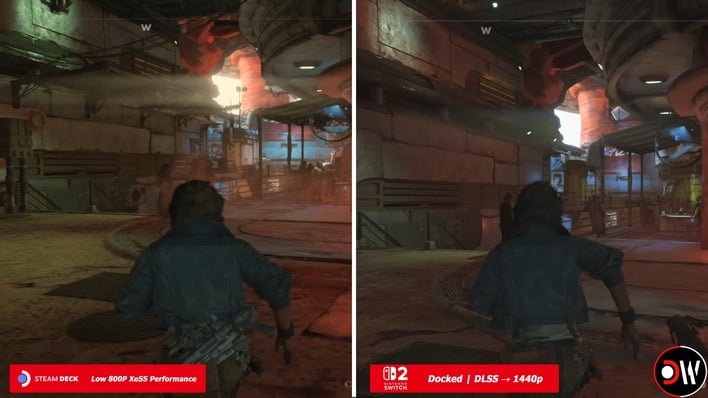
On the Steam Deck, even 30 FPS is simply impossible without frame generation due to the RDNA 2 architecture's poor ray-tracing performance, and using frame generation below a render framerate of about 50 FPS is a recipe for misery. Star Wars Outlaws makes use of ray-traced reflections as well as heavy ray-traced global illumination effects, and the tiny RDNA 2 GPU in the "Aerith" APU simply can't hack it. Meanwhile, the Switch 2 enjoys both a smoother frame rate and better image quality thanks to the use of AI-powered DLSS upscaling (or something akin to it, anyway.)
In practice, this scenario is likely to play out for a great many Switch 2 releases that make strong use of the NVIDIA hardware within. The higher-end PC gaming handhelds, like the MSI Claw 8 AI+ or the ASUS ROG Xbox Ally X, can easily outpace the Switch 2 through sheer PC horsepower, but against lower-end machines like the Steam Deck and the "non-X" Xbox handheld, the Switch 2's unique advantages give it the win here.
Nintendo Switch 2 Vs ROG Xbox Ally: Software Library And Final Considerations
So, what does all of this really mean? Is the ASUS ROG Xbox Ally simply an overpriced piece of hardware? Is Nintendo Switch 2 more powerful than the PC audience is giving it credit for? The truth falls somewhere in between. Compared to the likes of Steam Deck or last-gen Ryzen Z1 Extreme handhelds with greater performance now available at a lower price, the lower-end ASUS ROG Xbox Ally might appear somewhat questionable in value. It's not likely to outpace the Steam Deck, yet it's nearly $200 more expensive than that system. The Xbox Ally X is a much more compelling proposition next to the Switch 2, but that machine costs more than twice as much as Nintendo's finest. Performance gains beyond that machine can easily meet or exceed $2000 in this form factor.The most reliable data available suggests that Nintendo's first-party games make up over 80% of software sales on the Switch, and the first Switch is still the best-selling console of all time despite that (at least, in the United States.) With Switch 2 proving more capable of delivering modern experiences without too much trimming, Nintendo may be able to shake off the reputation of pathetic third-party game ports it acquired with the anemic Switch 1 hardware. Of course, the machine is still pushing record-breaking sales at time of writing, so that may not matter in any case.
But the Nintendo Switch 2 does come with substantial trade-offs for its Steam Deck-killing NVIDIA internals, including major compromises to the handheld's display and an available non-Nintendo game library. For some gamers, including the majority of our staff here, that makes the Nintendo Switch 2 a non-starter, at least until there's a Nintendo Switch 2 OLED model, which has yet to be announced and could realistically take years to manifest. Comparatively, especially if you're already invested into the PC gaming ecosystem, the ASUS ROG Xbox Ally handhelds do have a lot to offer, just at perhaps a higher price point than is necessarily justifiable. Ironically, the ASUS ROG Xbox Ally may be more compelling if it came with SteamOS.
The expansive and inexpensive library available to PC handhelds, especially with emulation, is certainly remarkable, and the ability to use your handheld the same way you'd use a laptop (albeit with external accessories) can be useful in a pinch. Conversely, the sheer performance and long battery life of the Nintendo Switch 2, especially with optimized ports and natively-enhanced versions of Switch 1 games available for the hardware, is also quite compelling. Although, the fact that it includes a dock which no other handheld in this price point does is also a standout feature.
Here are a few shopping links to tap on for reference, in the event you're itching to move on one of these devices someday soon...
- ASUS ROG Xbox Ally—$599.99
- ASUS ROG Xbox Ally X—$999.99
- Nintendo Switch 2—$449.99

